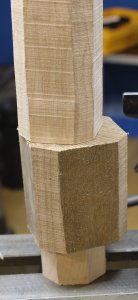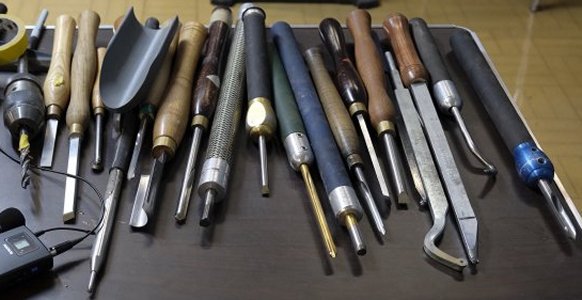
Some 40 Members enjoyed a chatty & humorous evening with Les Thorne, (who had
come from a day's work turning green Oak).
Les envied a hobby woodturner's lot who could turn what and when they liked.
He was a Jobbing Woodturner, which meant he had to turn what others wanted for
when they wanted them.
Consequently, he listed his hobbies as golf & fishing and never woodturning.
His woodturning meant constantly looking at how long a job would take. For
example, if his first gouge work was to turn the piece from square to a
cylinder, he would reduce time wasted in moving his tool rest from its starting
position by cutting several squares at a time into octagons with his bandsaw;
when there are 100 units to turn, that apparent extra job saves about an hour
overall.

Since his last visit, he has moved away from colour and texturing demonstrations
as he had noticed that very few recreational woodturners chose such finishes in
preference to just working with the wood.
Tonight,
Les was making a box with a reversible finial while spotlighting basic gouge work and planning considerations along the way.
Starting with a 3˝" octagon of Oak for the body and 2 pieces of Sycamore (which
Les considers as Hampshire Weed) for the base and for the double ended finial.
The Oak octagon was mounted between centres and turned to a cylinder.
From a professional's point of view to be productive, one has to be as quick and
effective as possible and there is no reason why the hobbyist shouldn't be the
same.
Les talked about presenting the Roughing Gouge at its 'sweet point' and
maintaining the angle with body movement. Faster body movement achieved
quicker removal but concluding with slower movements achieved a smoother finish.
A common fault with hobbyists was allowing the bevel angle to get larger than
the ideal 40°- 45° when sharpening. A longer bevel may have a weaker edge but it
remains sharper for longer if always presented at its 'sweet point'.
Les used the centre quadrant of his Roughing Gouge's cutting edge for the quick
removal and kept the outer quadrants sharp for his smoother finishes.
With a cylinder turned, he needed a spigot to fit his chuck. Les prefers to
create this at the head stock end of the piece where the best support is found.
The initial hollowing could be done with a gouge or a drill. If the latter, he
suggested to enlarge the centre point of the piece with the tip of your tool
sufficiently to avoid the drill bit 'skating' over the end surface and ending up
off-centre.
Les started with a Spindle Gouge with a reasonably fast lathe speed to better
throw out the shavings.
He finished off the hollowing showing the pros & cons of various hollowing
tools.

(click for close up view)
Surprisingly, the smallest diameter scraper seemed to be the quickest at
removing the inside.

Les is a great advocate for not letting a spigot dictate the size of the base.
In tonight's case, the hollowed body was shaped like a trophy cup finishing off
narrow at the bottom allowing only a small diameter spigot. An appropriate
design to connect to the base was small at the top, wide enough at the bottom to
avoid topple while remaining squat overall. He demonstrated how his Detail Tool could get
into tight spaces and how it could produce a smooth
finish with just its pointed corner.
Rather than parting off completely, Les chose to part down to leave a central
stub of a
couple of millimetres diameter which could then be easily & accurately
removed with abrasives.
Finials need to be in balance with the overall piece; what Les described as,
"seen but not heard." They shouldn't dominate nor should they appear
measly. The ideal woods to select for fine detailing tend to be fruit woods;
Cherry, Holly etc.
Tonight's finial was going to be double ended so thought had to be given as to
how to mount the wood to turn the second finial after completing the first.
With the last piece of Sycamore between centres, Les turned a spigot to fit his
chuck and demonstrated various techniques to produce a tall, thin finial coming
from a base turned accurately to the top lip of the finished body.
Having cunningly planned the diameter of the body's lid to be oversized compared
to the chuck's true circle diameter, there was now plenty of room for the tall
thin finial to disappear down the centre of the chuck while allowing the jaws to
grip the first finial's base securely before turning the second finial.
There is little point in turning a identical finial to the first so Les decided
upon a door knob type.
It is worth noting that all surfaces in the above photos are remarkably, just
tool finished.
Les didn't want to bother with abrasives in order to complete the demonstration
within time.
The May Competition was set for a turned example of a vessel with a finial.
(photos by Vic Russell, Andy Ogilvie & Rick Patrick)
<to
Pro Index>
Les Thorne is a Registered Professional Turner (RPT) and Liveryman of the
Worshipful Company of Turners.
He can be found at
<thewoodturningshop.com>
Les Thorne
6th May 2017
Les gave a very interesting demo in a jovial manner with amusing quips as
well as useful hints & tips along the way.
He demonstrated 3 pieces :- a carved and decorated box, an ash bowl decorated
with torching and lime wax and a wet elm natural edge bowl.
He also gave a quick but useful guide on that bęte noire of turners , the skew
chisel, even showing that you could use a screwdriver in certain places when
sharpened.
Decorated Box -
Ash Bowl - Torched & Liming-waxed
Natural Edge Bowl in wet Elm